Brand Management Report: Branding, Strategy, and Equity Analysis
VerifiedAdded on 2020/12/09
|20
|7578
|136
Report
AI Summary
This report delves into the core concepts of brand management, focusing on the importance of branding as a marketing tool and its evolution in business practice. It analyzes the key components of a successful brand strategy, emphasizing the building and management of brand equity, with Optimum Impression Limited and SAMSUNG as case studies. The report explores different strategies for portfolio management, brand hierarchy, and brand equity management, as well as collaborative brand management approaches at both domestic and global levels. Furthermore, it evaluates various techniques for measuring and managing brand value, supported by organizational examples, and concludes with a synthesis of the findings and recommendations for effective brand management practices. The report also examines the Customer-Based Brand Equity (CBBE) model.
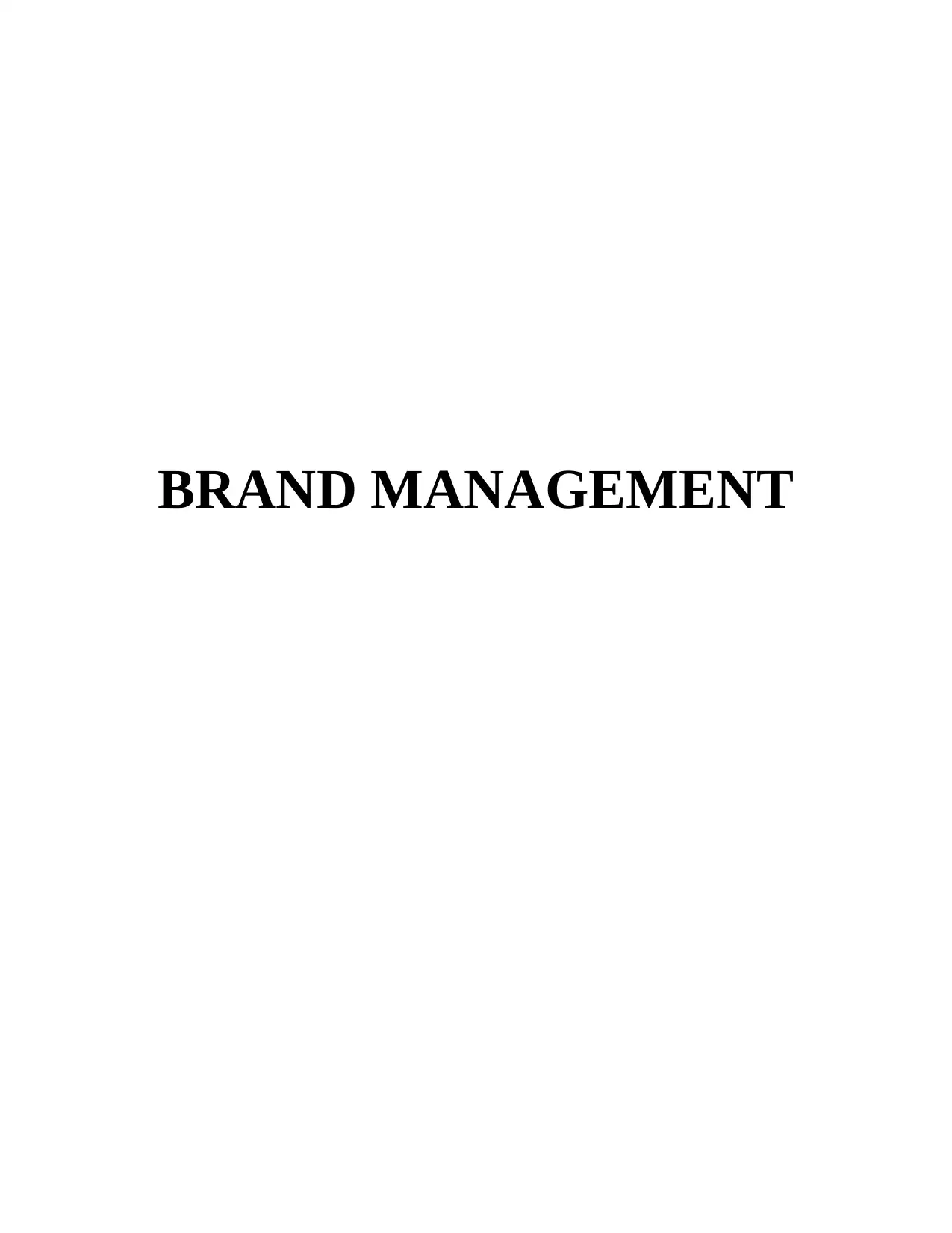
BRAND MANAGEMENT
Paraphrase This Document
Need a fresh take? Get an instant paraphrase of this document with our AI Paraphraser
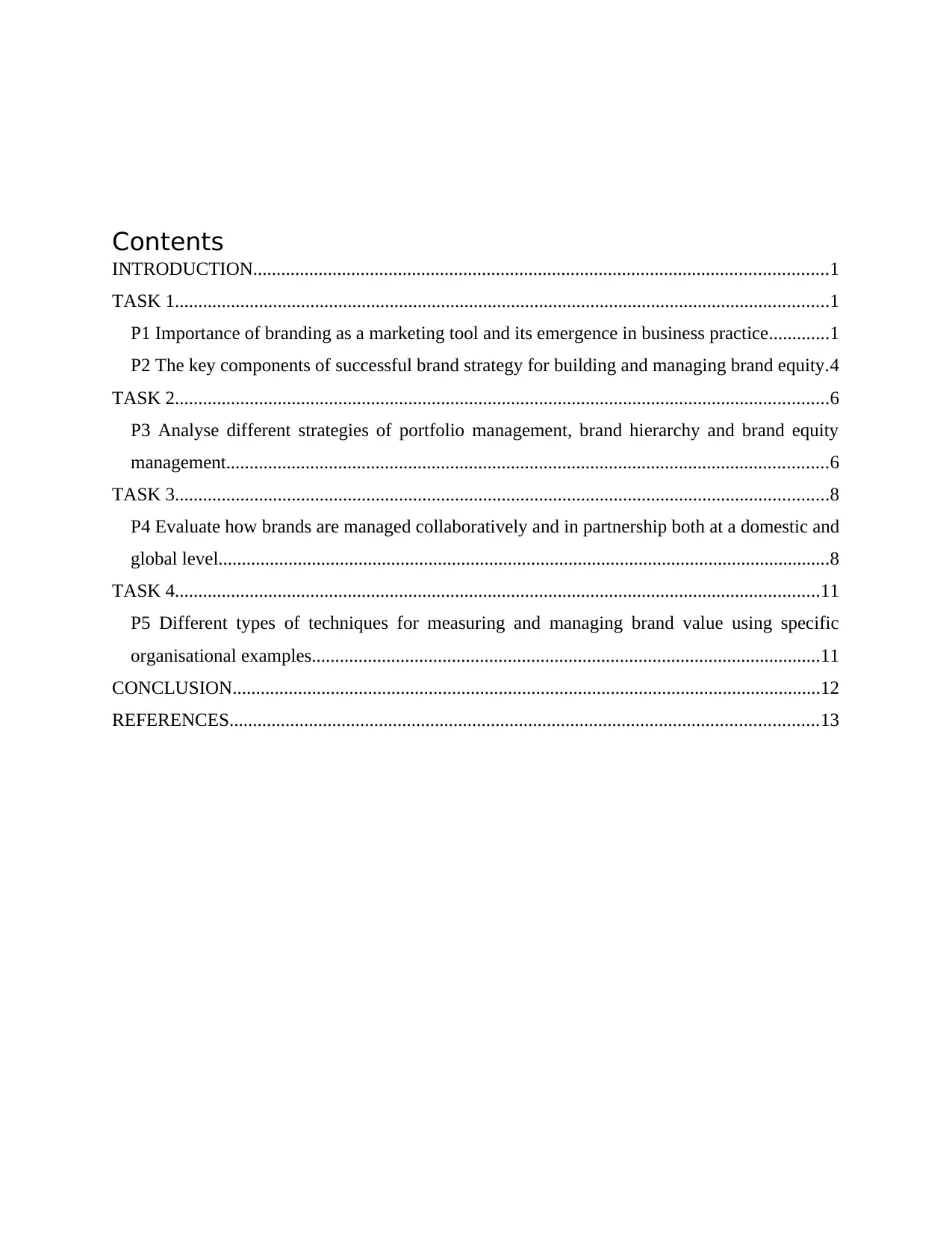
Contents
INTRODUCTION...........................................................................................................................1
TASK 1............................................................................................................................................1
P1 Importance of branding as a marketing tool and its emergence in business practice.............1
P2 The key components of successful brand strategy for building and managing brand equity.4
TASK 2............................................................................................................................................6
P3 Analyse different strategies of portfolio management, brand hierarchy and brand equity
management.................................................................................................................................6
TASK 3............................................................................................................................................8
P4 Evaluate how brands are managed collaboratively and in partnership both at a domestic and
global level...................................................................................................................................8
TASK 4..........................................................................................................................................11
P5 Different types of techniques for measuring and managing brand value using specific
organisational examples.............................................................................................................11
CONCLUSION..............................................................................................................................12
REFERENCES..............................................................................................................................13
INTRODUCTION...........................................................................................................................1
TASK 1............................................................................................................................................1
P1 Importance of branding as a marketing tool and its emergence in business practice.............1
P2 The key components of successful brand strategy for building and managing brand equity.4
TASK 2............................................................................................................................................6
P3 Analyse different strategies of portfolio management, brand hierarchy and brand equity
management.................................................................................................................................6
TASK 3............................................................................................................................................8
P4 Evaluate how brands are managed collaboratively and in partnership both at a domestic and
global level...................................................................................................................................8
TASK 4..........................................................................................................................................11
P5 Different types of techniques for measuring and managing brand value using specific
organisational examples.............................................................................................................11
CONCLUSION..............................................................................................................................12
REFERENCES..............................................................................................................................13
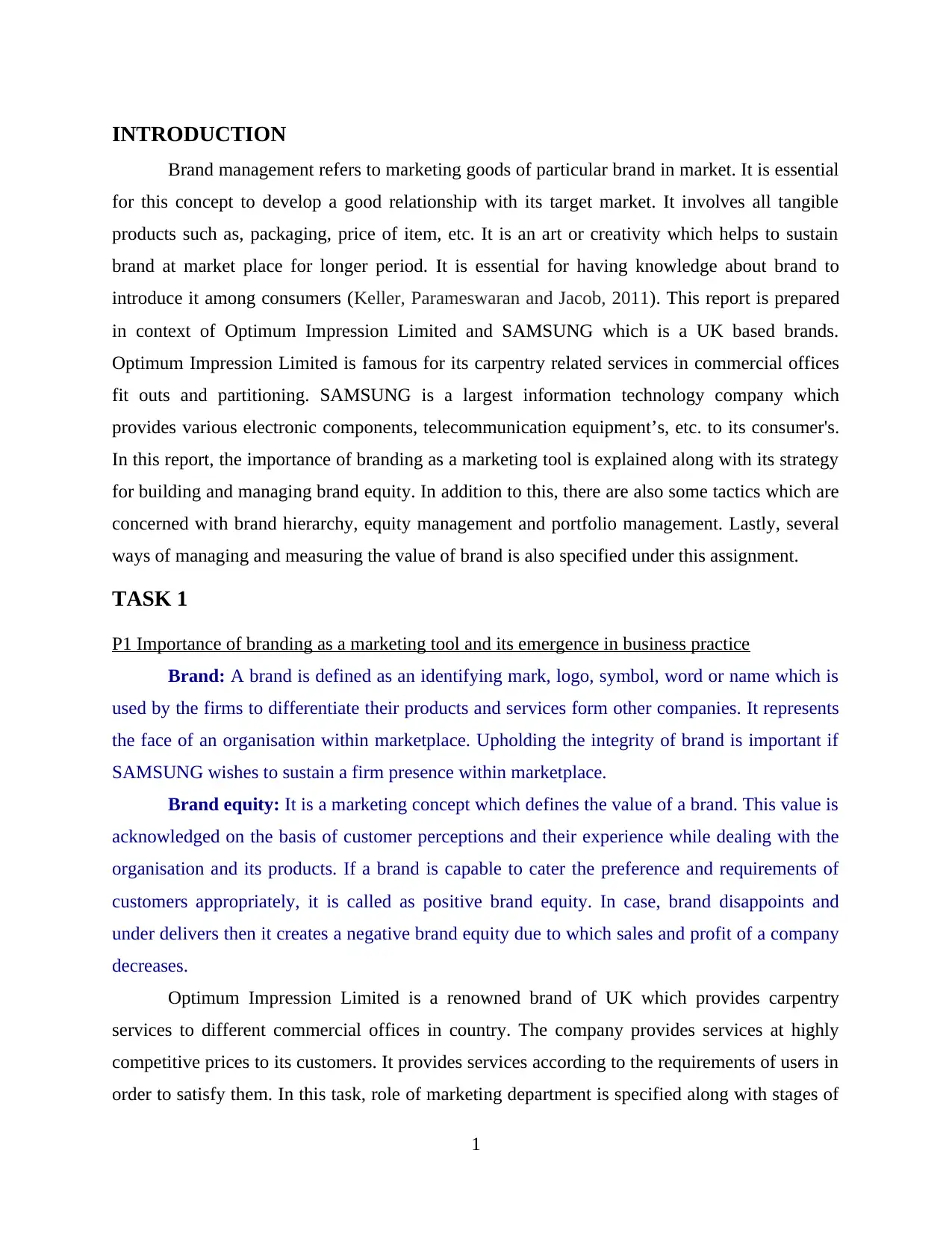
INTRODUCTION
Brand management refers to marketing goods of particular brand in market. It is essential
for this concept to develop a good relationship with its target market. It involves all tangible
products such as, packaging, price of item, etc. It is an art or creativity which helps to sustain
brand at market place for longer period. It is essential for having knowledge about brand to
introduce it among consumers (Keller, Parameswaran and Jacob, 2011). This report is prepared
in context of Optimum Impression Limited and SAMSUNG which is a UK based brands.
Optimum Impression Limited is famous for its carpentry related services in commercial offices
fit outs and partitioning. SAMSUNG is a largest information technology company which
provides various electronic components, telecommunication equipment’s, etc. to its consumer's.
In this report, the importance of branding as a marketing tool is explained along with its strategy
for building and managing brand equity. In addition to this, there are also some tactics which are
concerned with brand hierarchy, equity management and portfolio management. Lastly, several
ways of managing and measuring the value of brand is also specified under this assignment.
TASK 1
P1 Importance of branding as a marketing tool and its emergence in business practice
Brand: A brand is defined as an identifying mark, logo, symbol, word or name which is
used by the firms to differentiate their products and services form other companies. It represents
the face of an organisation within marketplace. Upholding the integrity of brand is important if
SAMSUNG wishes to sustain a firm presence within marketplace.
Brand equity: It is a marketing concept which defines the value of a brand. This value is
acknowledged on the basis of customer perceptions and their experience while dealing with the
organisation and its products. If a brand is capable to cater the preference and requirements of
customers appropriately, it is called as positive brand equity. In case, brand disappoints and
under delivers then it creates a negative brand equity due to which sales and profit of a company
decreases.
Optimum Impression Limited is a renowned brand of UK which provides carpentry
services to different commercial offices in country. The company provides services at highly
competitive prices to its customers. It provides services according to the requirements of users in
order to satisfy them. In this task, role of marketing department is specified along with stages of
1
Brand management refers to marketing goods of particular brand in market. It is essential
for this concept to develop a good relationship with its target market. It involves all tangible
products such as, packaging, price of item, etc. It is an art or creativity which helps to sustain
brand at market place for longer period. It is essential for having knowledge about brand to
introduce it among consumers (Keller, Parameswaran and Jacob, 2011). This report is prepared
in context of Optimum Impression Limited and SAMSUNG which is a UK based brands.
Optimum Impression Limited is famous for its carpentry related services in commercial offices
fit outs and partitioning. SAMSUNG is a largest information technology company which
provides various electronic components, telecommunication equipment’s, etc. to its consumer's.
In this report, the importance of branding as a marketing tool is explained along with its strategy
for building and managing brand equity. In addition to this, there are also some tactics which are
concerned with brand hierarchy, equity management and portfolio management. Lastly, several
ways of managing and measuring the value of brand is also specified under this assignment.
TASK 1
P1 Importance of branding as a marketing tool and its emergence in business practice
Brand: A brand is defined as an identifying mark, logo, symbol, word or name which is
used by the firms to differentiate their products and services form other companies. It represents
the face of an organisation within marketplace. Upholding the integrity of brand is important if
SAMSUNG wishes to sustain a firm presence within marketplace.
Brand equity: It is a marketing concept which defines the value of a brand. This value is
acknowledged on the basis of customer perceptions and their experience while dealing with the
organisation and its products. If a brand is capable to cater the preference and requirements of
customers appropriately, it is called as positive brand equity. In case, brand disappoints and
under delivers then it creates a negative brand equity due to which sales and profit of a company
decreases.
Optimum Impression Limited is a renowned brand of UK which provides carpentry
services to different commercial offices in country. The company provides services at highly
competitive prices to its customers. It provides services according to the requirements of users in
order to satisfy them. In this task, role of marketing department is specified along with stages of
1
⊘ This is a preview!⊘
Do you want full access?
Subscribe today to unlock all pages.

Trusted by 1+ million students worldwide
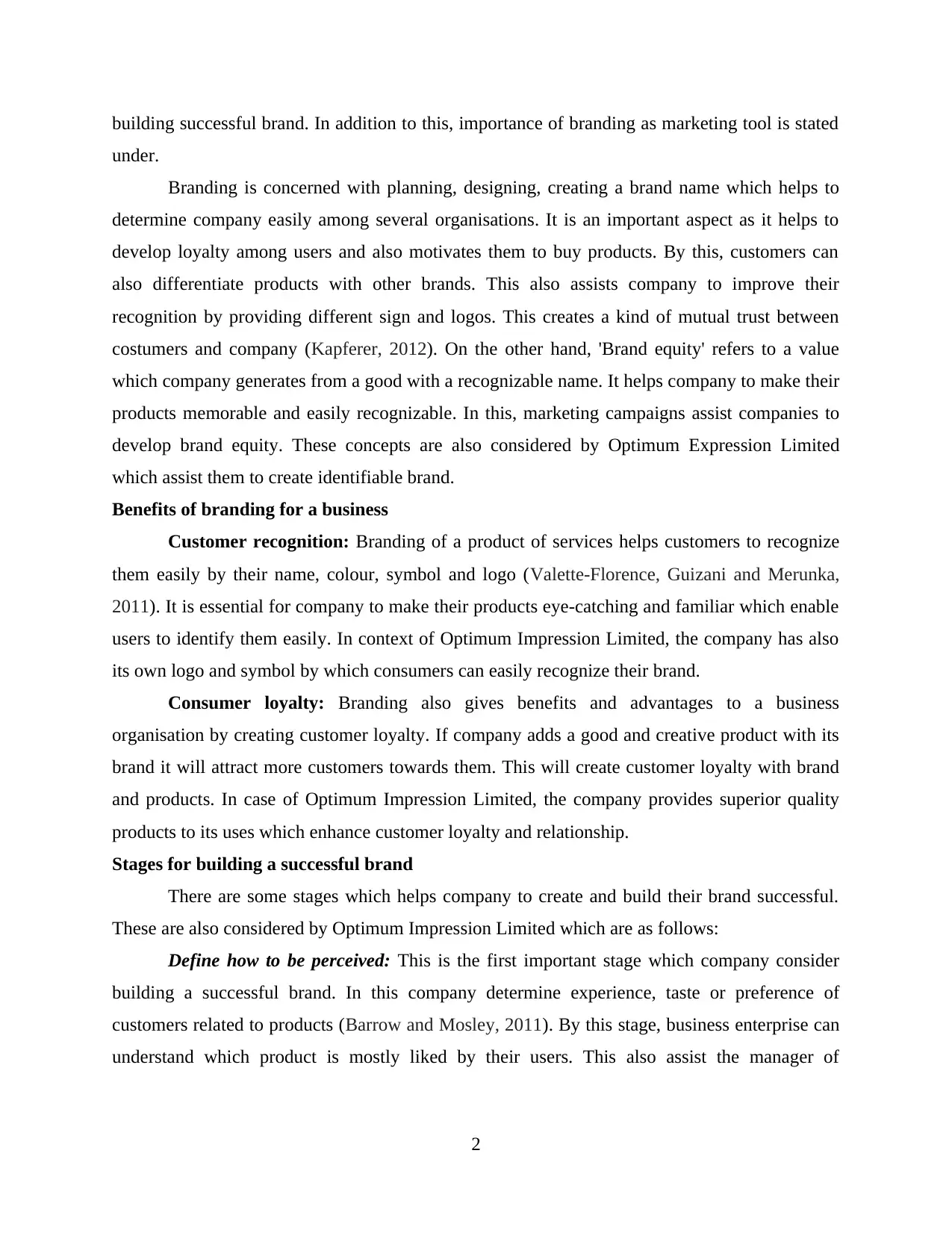
building successful brand. In addition to this, importance of branding as marketing tool is stated
under.
Branding is concerned with planning, designing, creating a brand name which helps to
determine company easily among several organisations. It is an important aspect as it helps to
develop loyalty among users and also motivates them to buy products. By this, customers can
also differentiate products with other brands. This also assists company to improve their
recognition by providing different sign and logos. This creates a kind of mutual trust between
costumers and company (Kapferer, 2012). On the other hand, 'Brand equity' refers to a value
which company generates from a good with a recognizable name. It helps company to make their
products memorable and easily recognizable. In this, marketing campaigns assist companies to
develop brand equity. These concepts are also considered by Optimum Expression Limited
which assist them to create identifiable brand.
Benefits of branding for a business
Customer recognition: Branding of a product of services helps customers to recognize
them easily by their name, colour, symbol and logo (Valette-Florence, Guizani and Merunka,
2011). It is essential for company to make their products eye-catching and familiar which enable
users to identify them easily. In context of Optimum Impression Limited, the company has also
its own logo and symbol by which consumers can easily recognize their brand.
Consumer loyalty: Branding also gives benefits and advantages to a business
organisation by creating customer loyalty. If company adds a good and creative product with its
brand it will attract more customers towards them. This will create customer loyalty with brand
and products. In case of Optimum Impression Limited, the company provides superior quality
products to its uses which enhance customer loyalty and relationship.
Stages for building a successful brand
There are some stages which helps company to create and build their brand successful.
These are also considered by Optimum Impression Limited which are as follows:
Define how to be perceived: This is the first important stage which company consider
building a successful brand. In this company determine experience, taste or preference of
customers related to products (Barrow and Mosley, 2011). By this stage, business enterprise can
understand which product is mostly liked by their users. This also assist the manager of
2
under.
Branding is concerned with planning, designing, creating a brand name which helps to
determine company easily among several organisations. It is an important aspect as it helps to
develop loyalty among users and also motivates them to buy products. By this, customers can
also differentiate products with other brands. This also assists company to improve their
recognition by providing different sign and logos. This creates a kind of mutual trust between
costumers and company (Kapferer, 2012). On the other hand, 'Brand equity' refers to a value
which company generates from a good with a recognizable name. It helps company to make their
products memorable and easily recognizable. In this, marketing campaigns assist companies to
develop brand equity. These concepts are also considered by Optimum Expression Limited
which assist them to create identifiable brand.
Benefits of branding for a business
Customer recognition: Branding of a product of services helps customers to recognize
them easily by their name, colour, symbol and logo (Valette-Florence, Guizani and Merunka,
2011). It is essential for company to make their products eye-catching and familiar which enable
users to identify them easily. In context of Optimum Impression Limited, the company has also
its own logo and symbol by which consumers can easily recognize their brand.
Consumer loyalty: Branding also gives benefits and advantages to a business
organisation by creating customer loyalty. If company adds a good and creative product with its
brand it will attract more customers towards them. This will create customer loyalty with brand
and products. In case of Optimum Impression Limited, the company provides superior quality
products to its uses which enhance customer loyalty and relationship.
Stages for building a successful brand
There are some stages which helps company to create and build their brand successful.
These are also considered by Optimum Impression Limited which are as follows:
Define how to be perceived: This is the first important stage which company consider
building a successful brand. In this company determine experience, taste or preference of
customers related to products (Barrow and Mosley, 2011). By this stage, business enterprise can
understand which product is mostly liked by their users. This also assist the manager of
2
Paraphrase This Document
Need a fresh take? Get an instant paraphrase of this document with our AI Paraphraser
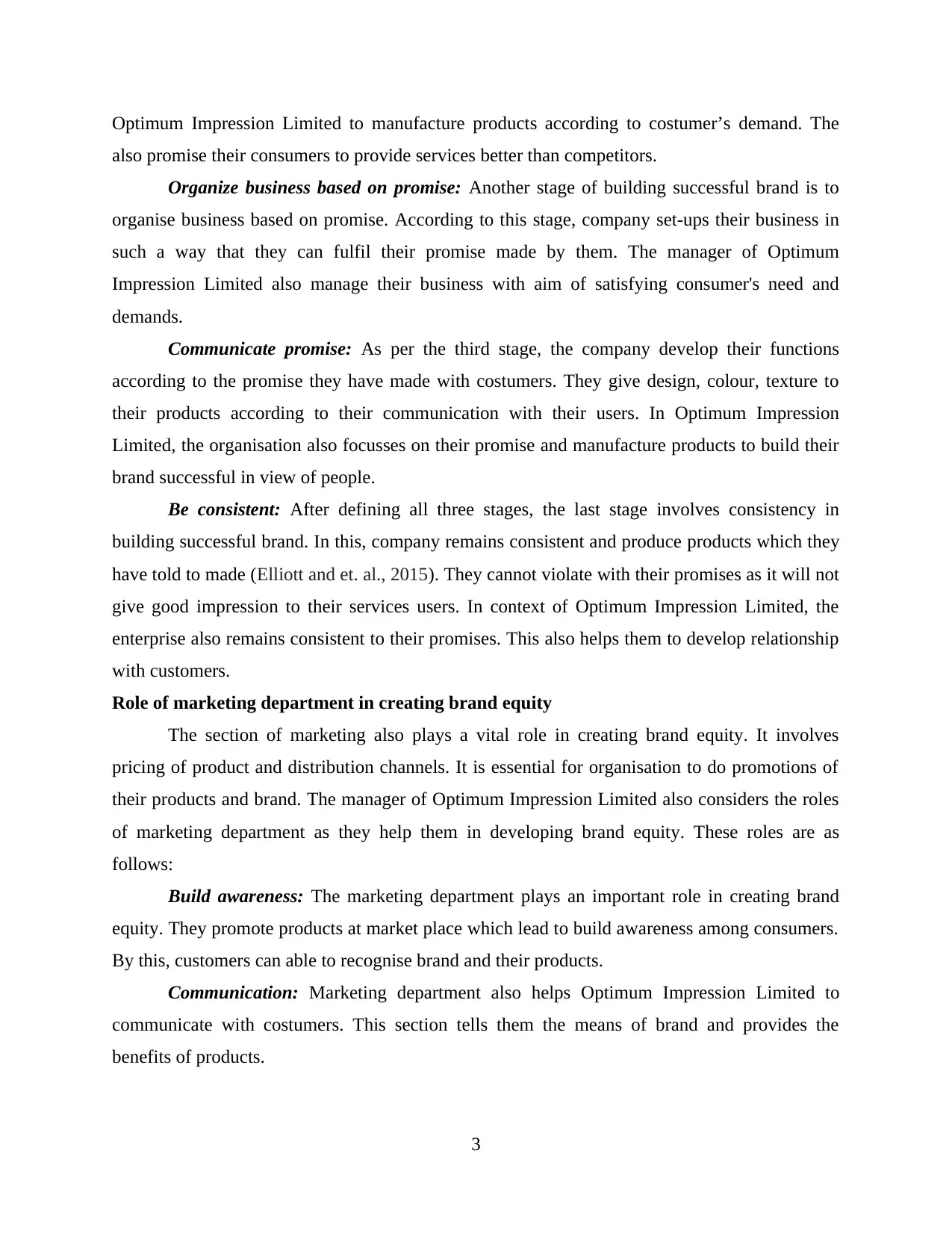
Optimum Impression Limited to manufacture products according to costumer’s demand. The
also promise their consumers to provide services better than competitors.
Organize business based on promise: Another stage of building successful brand is to
organise business based on promise. According to this stage, company set-ups their business in
such a way that they can fulfil their promise made by them. The manager of Optimum
Impression Limited also manage their business with aim of satisfying consumer's need and
demands.
Communicate promise: As per the third stage, the company develop their functions
according to the promise they have made with costumers. They give design, colour, texture to
their products according to their communication with their users. In Optimum Impression
Limited, the organisation also focusses on their promise and manufacture products to build their
brand successful in view of people.
Be consistent: After defining all three stages, the last stage involves consistency in
building successful brand. In this, company remains consistent and produce products which they
have told to made (Elliott and et. al., 2015). They cannot violate with their promises as it will not
give good impression to their services users. In context of Optimum Impression Limited, the
enterprise also remains consistent to their promises. This also helps them to develop relationship
with customers.
Role of marketing department in creating brand equity
The section of marketing also plays a vital role in creating brand equity. It involves
pricing of product and distribution channels. It is essential for organisation to do promotions of
their products and brand. The manager of Optimum Impression Limited also considers the roles
of marketing department as they help them in developing brand equity. These roles are as
follows:
Build awareness: The marketing department plays an important role in creating brand
equity. They promote products at market place which lead to build awareness among consumers.
By this, customers can able to recognise brand and their products.
Communication: Marketing department also helps Optimum Impression Limited to
communicate with costumers. This section tells them the means of brand and provides the
benefits of products.
3
also promise their consumers to provide services better than competitors.
Organize business based on promise: Another stage of building successful brand is to
organise business based on promise. According to this stage, company set-ups their business in
such a way that they can fulfil their promise made by them. The manager of Optimum
Impression Limited also manage their business with aim of satisfying consumer's need and
demands.
Communicate promise: As per the third stage, the company develop their functions
according to the promise they have made with costumers. They give design, colour, texture to
their products according to their communication with their users. In Optimum Impression
Limited, the organisation also focusses on their promise and manufacture products to build their
brand successful in view of people.
Be consistent: After defining all three stages, the last stage involves consistency in
building successful brand. In this, company remains consistent and produce products which they
have told to made (Elliott and et. al., 2015). They cannot violate with their promises as it will not
give good impression to their services users. In context of Optimum Impression Limited, the
enterprise also remains consistent to their promises. This also helps them to develop relationship
with customers.
Role of marketing department in creating brand equity
The section of marketing also plays a vital role in creating brand equity. It involves
pricing of product and distribution channels. It is essential for organisation to do promotions of
their products and brand. The manager of Optimum Impression Limited also considers the roles
of marketing department as they help them in developing brand equity. These roles are as
follows:
Build awareness: The marketing department plays an important role in creating brand
equity. They promote products at market place which lead to build awareness among consumers.
By this, customers can able to recognise brand and their products.
Communication: Marketing department also helps Optimum Impression Limited to
communicate with costumers. This section tells them the means of brand and provides the
benefits of products.
3
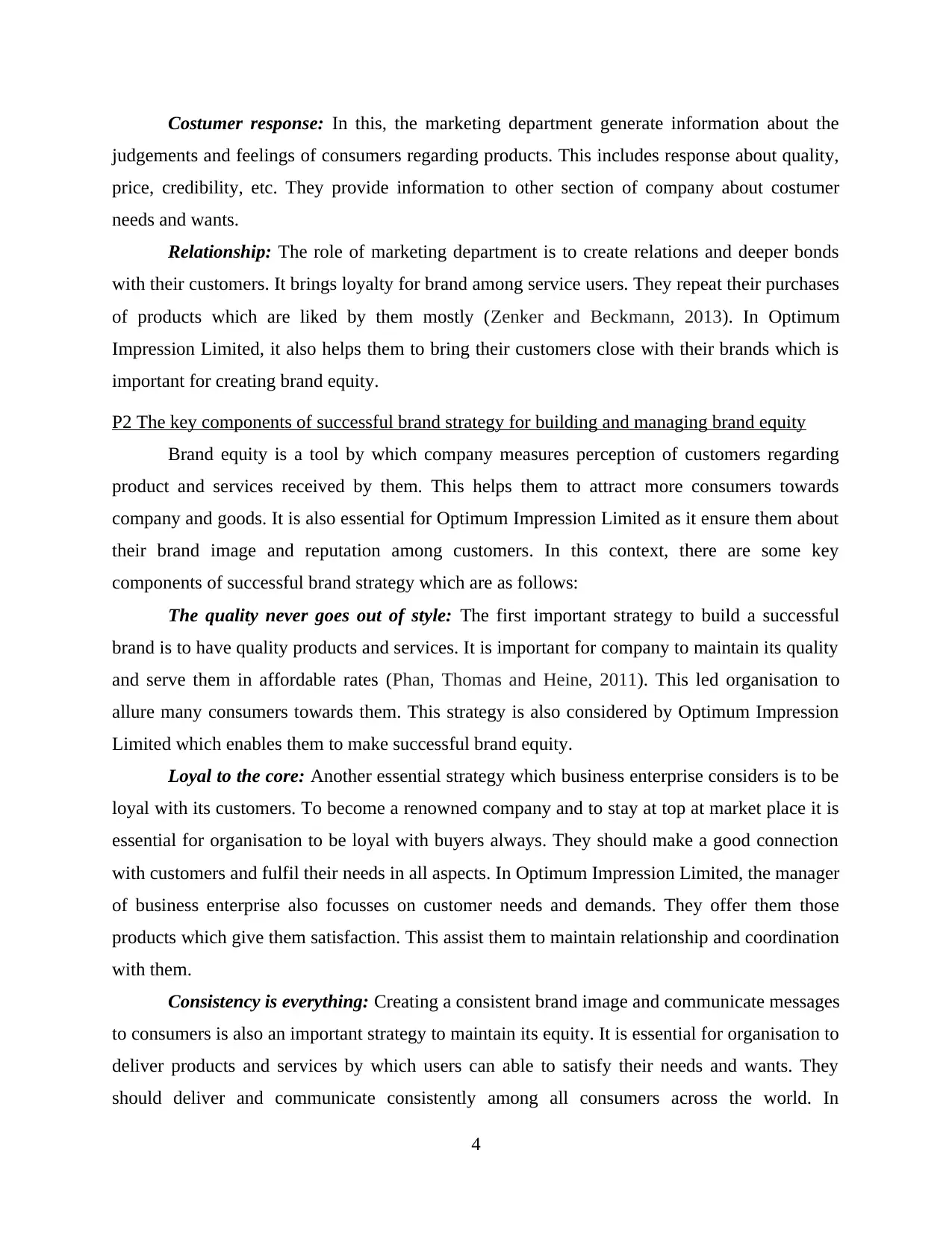
Costumer response: In this, the marketing department generate information about the
judgements and feelings of consumers regarding products. This includes response about quality,
price, credibility, etc. They provide information to other section of company about costumer
needs and wants.
Relationship: The role of marketing department is to create relations and deeper bonds
with their customers. It brings loyalty for brand among service users. They repeat their purchases
of products which are liked by them mostly (Zenker and Beckmann, 2013). In Optimum
Impression Limited, it also helps them to bring their customers close with their brands which is
important for creating brand equity.
P2 The key components of successful brand strategy for building and managing brand equity
Brand equity is a tool by which company measures perception of customers regarding
product and services received by them. This helps them to attract more consumers towards
company and goods. It is also essential for Optimum Impression Limited as it ensure them about
their brand image and reputation among customers. In this context, there are some key
components of successful brand strategy which are as follows:
The quality never goes out of style: The first important strategy to build a successful
brand is to have quality products and services. It is important for company to maintain its quality
and serve them in affordable rates (Phan, Thomas and Heine, 2011). This led organisation to
allure many consumers towards them. This strategy is also considered by Optimum Impression
Limited which enables them to make successful brand equity.
Loyal to the core: Another essential strategy which business enterprise considers is to be
loyal with its customers. To become a renowned company and to stay at top at market place it is
essential for organisation to be loyal with buyers always. They should make a good connection
with customers and fulfil their needs in all aspects. In Optimum Impression Limited, the manager
of business enterprise also focusses on customer needs and demands. They offer them those
products which give them satisfaction. This assist them to maintain relationship and coordination
with them.
Consistency is everything: Creating a consistent brand image and communicate messages
to consumers is also an important strategy to maintain its equity. It is essential for organisation to
deliver products and services by which users can able to satisfy their needs and wants. They
should deliver and communicate consistently among all consumers across the world. In
4
judgements and feelings of consumers regarding products. This includes response about quality,
price, credibility, etc. They provide information to other section of company about costumer
needs and wants.
Relationship: The role of marketing department is to create relations and deeper bonds
with their customers. It brings loyalty for brand among service users. They repeat their purchases
of products which are liked by them mostly (Zenker and Beckmann, 2013). In Optimum
Impression Limited, it also helps them to bring their customers close with their brands which is
important for creating brand equity.
P2 The key components of successful brand strategy for building and managing brand equity
Brand equity is a tool by which company measures perception of customers regarding
product and services received by them. This helps them to attract more consumers towards
company and goods. It is also essential for Optimum Impression Limited as it ensure them about
their brand image and reputation among customers. In this context, there are some key
components of successful brand strategy which are as follows:
The quality never goes out of style: The first important strategy to build a successful
brand is to have quality products and services. It is important for company to maintain its quality
and serve them in affordable rates (Phan, Thomas and Heine, 2011). This led organisation to
allure many consumers towards them. This strategy is also considered by Optimum Impression
Limited which enables them to make successful brand equity.
Loyal to the core: Another essential strategy which business enterprise considers is to be
loyal with its customers. To become a renowned company and to stay at top at market place it is
essential for organisation to be loyal with buyers always. They should make a good connection
with customers and fulfil their needs in all aspects. In Optimum Impression Limited, the manager
of business enterprise also focusses on customer needs and demands. They offer them those
products which give them satisfaction. This assist them to maintain relationship and coordination
with them.
Consistency is everything: Creating a consistent brand image and communicate messages
to consumers is also an important strategy to maintain its equity. It is essential for organisation to
deliver products and services by which users can able to satisfy their needs and wants. They
should deliver and communicate consistently among all consumers across the world. In
4
⊘ This is a preview!⊘
Do you want full access?
Subscribe today to unlock all pages.

Trusted by 1+ million students worldwide
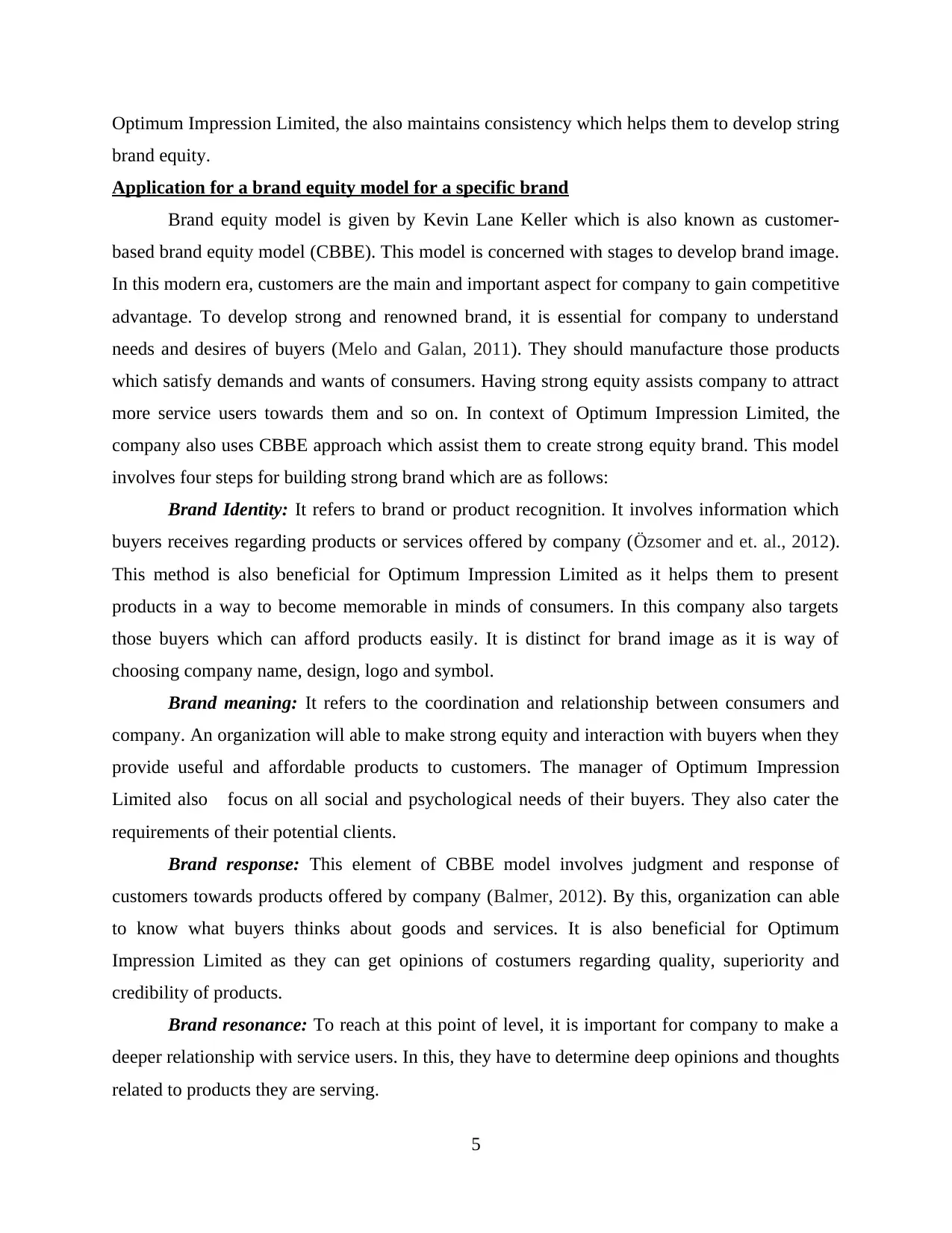
Optimum Impression Limited, the also maintains consistency which helps them to develop string
brand equity.
Application for a brand equity model for a specific brand
Brand equity model is given by Kevin Lane Keller which is also known as customer-
based brand equity model (CBBE). This model is concerned with stages to develop brand image.
In this modern era, customers are the main and important aspect for company to gain competitive
advantage. To develop strong and renowned brand, it is essential for company to understand
needs and desires of buyers (Melo and Galan, 2011). They should manufacture those products
which satisfy demands and wants of consumers. Having strong equity assists company to attract
more service users towards them and so on. In context of Optimum Impression Limited, the
company also uses CBBE approach which assist them to create strong equity brand. This model
involves four steps for building strong brand which are as follows:
Brand Identity: It refers to brand or product recognition. It involves information which
buyers receives regarding products or services offered by company (Özsomer and et. al., 2012).
This method is also beneficial for Optimum Impression Limited as it helps them to present
products in a way to become memorable in minds of consumers. In this company also targets
those buyers which can afford products easily. It is distinct for brand image as it is way of
choosing company name, design, logo and symbol.
Brand meaning: It refers to the coordination and relationship between consumers and
company. An organization will able to make strong equity and interaction with buyers when they
provide useful and affordable products to customers. The manager of Optimum Impression
Limited also focus on all social and psychological needs of their buyers. They also cater the
requirements of their potential clients.
Brand response: This element of CBBE model involves judgment and response of
customers towards products offered by company (Balmer, 2012). By this, organization can able
to know what buyers thinks about goods and services. It is also beneficial for Optimum
Impression Limited as they can get opinions of costumers regarding quality, superiority and
credibility of products.
Brand resonance: To reach at this point of level, it is important for company to make a
deeper relationship with service users. In this, they have to determine deep opinions and thoughts
related to products they are serving.
5
brand equity.
Application for a brand equity model for a specific brand
Brand equity model is given by Kevin Lane Keller which is also known as customer-
based brand equity model (CBBE). This model is concerned with stages to develop brand image.
In this modern era, customers are the main and important aspect for company to gain competitive
advantage. To develop strong and renowned brand, it is essential for company to understand
needs and desires of buyers (Melo and Galan, 2011). They should manufacture those products
which satisfy demands and wants of consumers. Having strong equity assists company to attract
more service users towards them and so on. In context of Optimum Impression Limited, the
company also uses CBBE approach which assist them to create strong equity brand. This model
involves four steps for building strong brand which are as follows:
Brand Identity: It refers to brand or product recognition. It involves information which
buyers receives regarding products or services offered by company (Özsomer and et. al., 2012).
This method is also beneficial for Optimum Impression Limited as it helps them to present
products in a way to become memorable in minds of consumers. In this company also targets
those buyers which can afford products easily. It is distinct for brand image as it is way of
choosing company name, design, logo and symbol.
Brand meaning: It refers to the coordination and relationship between consumers and
company. An organization will able to make strong equity and interaction with buyers when they
provide useful and affordable products to customers. The manager of Optimum Impression
Limited also focus on all social and psychological needs of their buyers. They also cater the
requirements of their potential clients.
Brand response: This element of CBBE model involves judgment and response of
customers towards products offered by company (Balmer, 2012). By this, organization can able
to know what buyers thinks about goods and services. It is also beneficial for Optimum
Impression Limited as they can get opinions of costumers regarding quality, superiority and
credibility of products.
Brand resonance: To reach at this point of level, it is important for company to make a
deeper relationship with service users. In this, they have to determine deep opinions and thoughts
related to products they are serving.
5
Paraphrase This Document
Need a fresh take? Get an instant paraphrase of this document with our AI Paraphraser
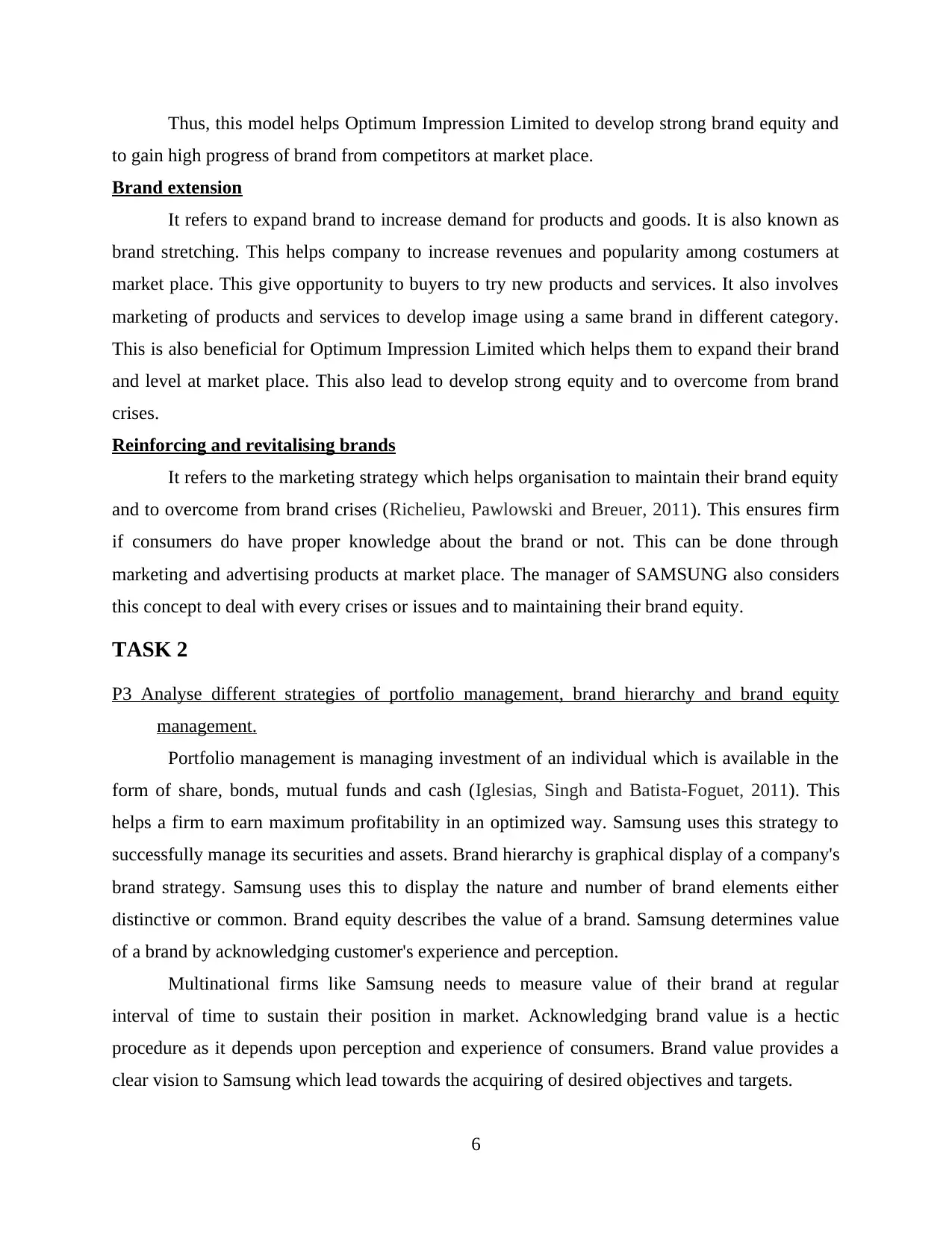
Thus, this model helps Optimum Impression Limited to develop strong brand equity and
to gain high progress of brand from competitors at market place.
Brand extension
It refers to expand brand to increase demand for products and goods. It is also known as
brand stretching. This helps company to increase revenues and popularity among costumers at
market place. This give opportunity to buyers to try new products and services. It also involves
marketing of products and services to develop image using a same brand in different category.
This is also beneficial for Optimum Impression Limited which helps them to expand their brand
and level at market place. This also lead to develop strong equity and to overcome from brand
crises.
Reinforcing and revitalising brands
It refers to the marketing strategy which helps organisation to maintain their brand equity
and to overcome from brand crises (Richelieu, Pawlowski and Breuer, 2011). This ensures firm
if consumers do have proper knowledge about the brand or not. This can be done through
marketing and advertising products at market place. The manager of SAMSUNG also considers
this concept to deal with every crises or issues and to maintaining their brand equity.
TASK 2
P3 Analyse different strategies of portfolio management, brand hierarchy and brand equity
management.
Portfolio management is managing investment of an individual which is available in the
form of share, bonds, mutual funds and cash (Iglesias, Singh and Batista-Foguet, 2011). This
helps a firm to earn maximum profitability in an optimized way. Samsung uses this strategy to
successfully manage its securities and assets. Brand hierarchy is graphical display of a company's
brand strategy. Samsung uses this to display the nature and number of brand elements either
distinctive or common. Brand equity describes the value of a brand. Samsung determines value
of a brand by acknowledging customer's experience and perception.
Multinational firms like Samsung needs to measure value of their brand at regular
interval of time to sustain their position in market. Acknowledging brand value is a hectic
procedure as it depends upon perception and experience of consumers. Brand value provides a
clear vision to Samsung which lead towards the acquiring of desired objectives and targets.
6
to gain high progress of brand from competitors at market place.
Brand extension
It refers to expand brand to increase demand for products and goods. It is also known as
brand stretching. This helps company to increase revenues and popularity among costumers at
market place. This give opportunity to buyers to try new products and services. It also involves
marketing of products and services to develop image using a same brand in different category.
This is also beneficial for Optimum Impression Limited which helps them to expand their brand
and level at market place. This also lead to develop strong equity and to overcome from brand
crises.
Reinforcing and revitalising brands
It refers to the marketing strategy which helps organisation to maintain their brand equity
and to overcome from brand crises (Richelieu, Pawlowski and Breuer, 2011). This ensures firm
if consumers do have proper knowledge about the brand or not. This can be done through
marketing and advertising products at market place. The manager of SAMSUNG also considers
this concept to deal with every crises or issues and to maintaining their brand equity.
TASK 2
P3 Analyse different strategies of portfolio management, brand hierarchy and brand equity
management.
Portfolio management is managing investment of an individual which is available in the
form of share, bonds, mutual funds and cash (Iglesias, Singh and Batista-Foguet, 2011). This
helps a firm to earn maximum profitability in an optimized way. Samsung uses this strategy to
successfully manage its securities and assets. Brand hierarchy is graphical display of a company's
brand strategy. Samsung uses this to display the nature and number of brand elements either
distinctive or common. Brand equity describes the value of a brand. Samsung determines value
of a brand by acknowledging customer's experience and perception.
Multinational firms like Samsung needs to measure value of their brand at regular
interval of time to sustain their position in market. Acknowledging brand value is a hectic
procedure as it depends upon perception and experience of consumers. Brand value provides a
clear vision to Samsung which lead towards the acquiring of desired objectives and targets.
6
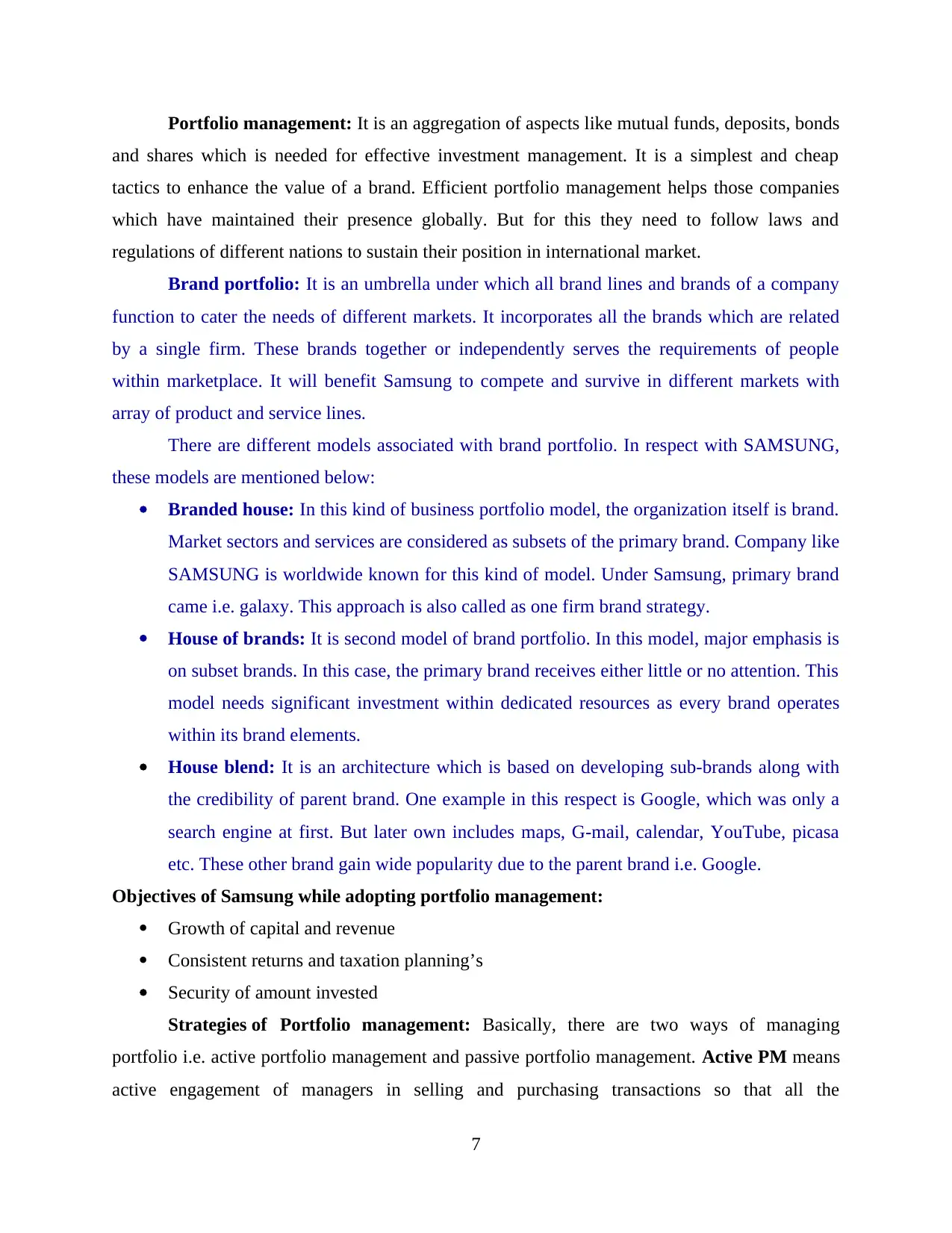
Portfolio management: It is an aggregation of aspects like mutual funds, deposits, bonds
and shares which is needed for effective investment management. It is a simplest and cheap
tactics to enhance the value of a brand. Efficient portfolio management helps those companies
which have maintained their presence globally. But for this they need to follow laws and
regulations of different nations to sustain their position in international market.
Brand portfolio: It is an umbrella under which all brand lines and brands of a company
function to cater the needs of different markets. It incorporates all the brands which are related
by a single firm. These brands together or independently serves the requirements of people
within marketplace. It will benefit Samsung to compete and survive in different markets with
array of product and service lines.
There are different models associated with brand portfolio. In respect with SAMSUNG,
these models are mentioned below:
Branded house: In this kind of business portfolio model, the organization itself is brand.
Market sectors and services are considered as subsets of the primary brand. Company like
SAMSUNG is worldwide known for this kind of model. Under Samsung, primary brand
came i.e. galaxy. This approach is also called as one firm brand strategy.
House of brands: It is second model of brand portfolio. In this model, major emphasis is
on subset brands. In this case, the primary brand receives either little or no attention. This
model needs significant investment within dedicated resources as every brand operates
within its brand elements.
House blend: It is an architecture which is based on developing sub-brands along with
the credibility of parent brand. One example in this respect is Google, which was only a
search engine at first. But later own includes maps, G-mail, calendar, YouTube, picasa
etc. These other brand gain wide popularity due to the parent brand i.e. Google.
Objectives of Samsung while adopting portfolio management:
Growth of capital and revenue
Consistent returns and taxation planning’s
Security of amount invested
Strategies of Portfolio management: Basically, there are two ways of managing
portfolio i.e. active portfolio management and passive portfolio management. Active PM means
active engagement of managers in selling and purchasing transactions so that all the
7
and shares which is needed for effective investment management. It is a simplest and cheap
tactics to enhance the value of a brand. Efficient portfolio management helps those companies
which have maintained their presence globally. But for this they need to follow laws and
regulations of different nations to sustain their position in international market.
Brand portfolio: It is an umbrella under which all brand lines and brands of a company
function to cater the needs of different markets. It incorporates all the brands which are related
by a single firm. These brands together or independently serves the requirements of people
within marketplace. It will benefit Samsung to compete and survive in different markets with
array of product and service lines.
There are different models associated with brand portfolio. In respect with SAMSUNG,
these models are mentioned below:
Branded house: In this kind of business portfolio model, the organization itself is brand.
Market sectors and services are considered as subsets of the primary brand. Company like
SAMSUNG is worldwide known for this kind of model. Under Samsung, primary brand
came i.e. galaxy. This approach is also called as one firm brand strategy.
House of brands: It is second model of brand portfolio. In this model, major emphasis is
on subset brands. In this case, the primary brand receives either little or no attention. This
model needs significant investment within dedicated resources as every brand operates
within its brand elements.
House blend: It is an architecture which is based on developing sub-brands along with
the credibility of parent brand. One example in this respect is Google, which was only a
search engine at first. But later own includes maps, G-mail, calendar, YouTube, picasa
etc. These other brand gain wide popularity due to the parent brand i.e. Google.
Objectives of Samsung while adopting portfolio management:
Growth of capital and revenue
Consistent returns and taxation planning’s
Security of amount invested
Strategies of Portfolio management: Basically, there are two ways of managing
portfolio i.e. active portfolio management and passive portfolio management. Active PM means
active engagement of managers in selling and purchasing transactions so that all the
7
⊘ This is a preview!⊘
Do you want full access?
Subscribe today to unlock all pages.

Trusted by 1+ million students worldwide
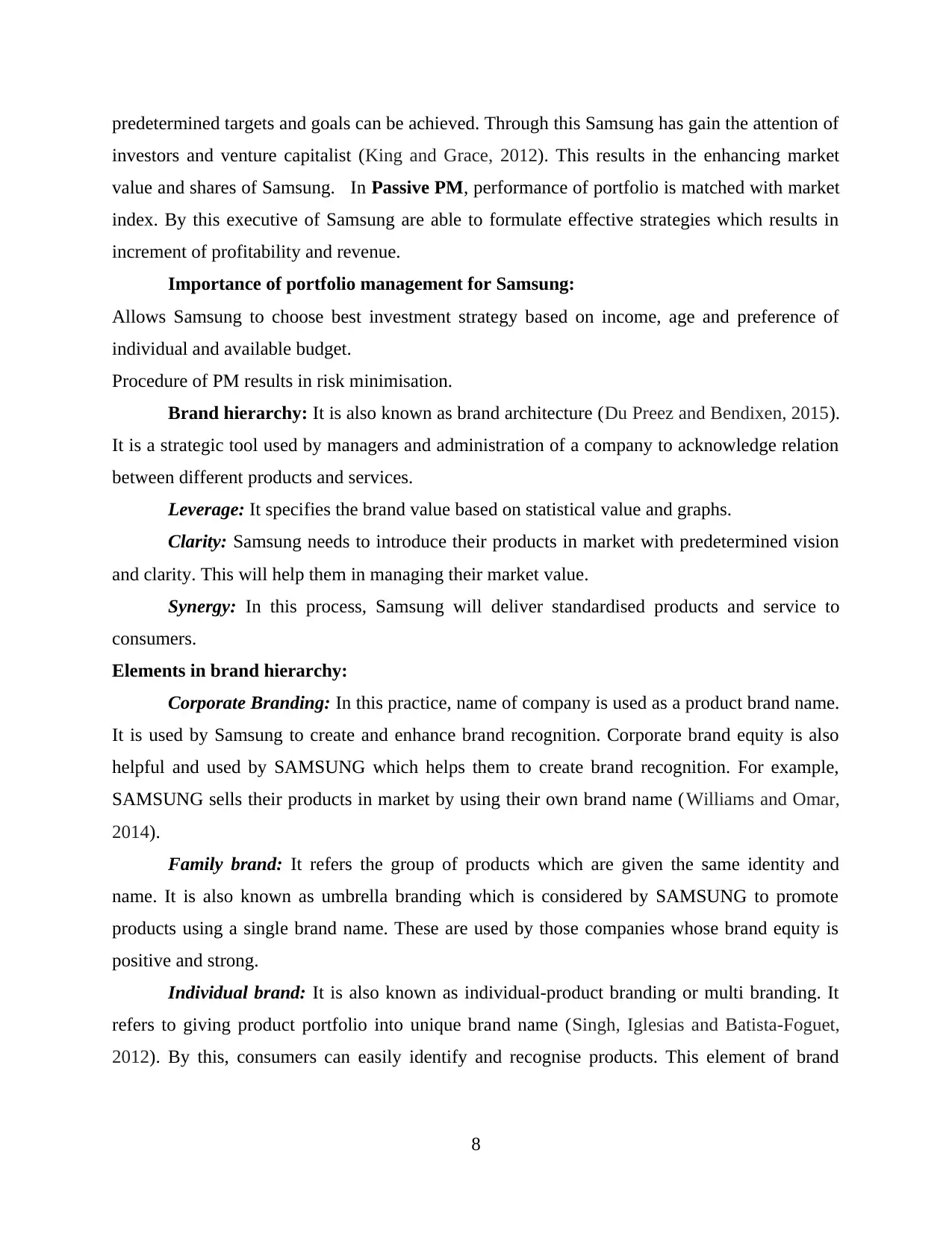
predetermined targets and goals can be achieved. Through this Samsung has gain the attention of
investors and venture capitalist (King and Grace, 2012). This results in the enhancing market
value and shares of Samsung. In Passive PM, performance of portfolio is matched with market
index. By this executive of Samsung are able to formulate effective strategies which results in
increment of profitability and revenue.
Importance of portfolio management for Samsung:
Allows Samsung to choose best investment strategy based on income, age and preference of
individual and available budget.
Procedure of PM results in risk minimisation.
Brand hierarchy: It is also known as brand architecture (Du Preez and Bendixen, 2015).
It is a strategic tool used by managers and administration of a company to acknowledge relation
between different products and services.
Leverage: It specifies the brand value based on statistical value and graphs.
Clarity: Samsung needs to introduce their products in market with predetermined vision
and clarity. This will help them in managing their market value.
Synergy: In this process, Samsung will deliver standardised products and service to
consumers.
Elements in brand hierarchy:
Corporate Branding: In this practice, name of company is used as a product brand name.
It is used by Samsung to create and enhance brand recognition. Corporate brand equity is also
helpful and used by SAMSUNG which helps them to create brand recognition. For example,
SAMSUNG sells their products in market by using their own brand name (Williams and Omar,
2014).
Family brand: It refers the group of products which are given the same identity and
name. It is also known as umbrella branding which is considered by SAMSUNG to promote
products using a single brand name. These are used by those companies whose brand equity is
positive and strong.
Individual brand: It is also known as individual-product branding or multi branding. It
refers to giving product portfolio into unique brand name (Singh, Iglesias and Batista-Foguet,
2012). By this, consumers can easily identify and recognise products. This element of brand
8
investors and venture capitalist (King and Grace, 2012). This results in the enhancing market
value and shares of Samsung. In Passive PM, performance of portfolio is matched with market
index. By this executive of Samsung are able to formulate effective strategies which results in
increment of profitability and revenue.
Importance of portfolio management for Samsung:
Allows Samsung to choose best investment strategy based on income, age and preference of
individual and available budget.
Procedure of PM results in risk minimisation.
Brand hierarchy: It is also known as brand architecture (Du Preez and Bendixen, 2015).
It is a strategic tool used by managers and administration of a company to acknowledge relation
between different products and services.
Leverage: It specifies the brand value based on statistical value and graphs.
Clarity: Samsung needs to introduce their products in market with predetermined vision
and clarity. This will help them in managing their market value.
Synergy: In this process, Samsung will deliver standardised products and service to
consumers.
Elements in brand hierarchy:
Corporate Branding: In this practice, name of company is used as a product brand name.
It is used by Samsung to create and enhance brand recognition. Corporate brand equity is also
helpful and used by SAMSUNG which helps them to create brand recognition. For example,
SAMSUNG sells their products in market by using their own brand name (Williams and Omar,
2014).
Family brand: It refers the group of products which are given the same identity and
name. It is also known as umbrella branding which is considered by SAMSUNG to promote
products using a single brand name. These are used by those companies whose brand equity is
positive and strong.
Individual brand: It is also known as individual-product branding or multi branding. It
refers to giving product portfolio into unique brand name (Singh, Iglesias and Batista-Foguet,
2012). By this, consumers can easily identify and recognise products. This element of brand
8
Paraphrase This Document
Need a fresh take? Get an instant paraphrase of this document with our AI Paraphraser
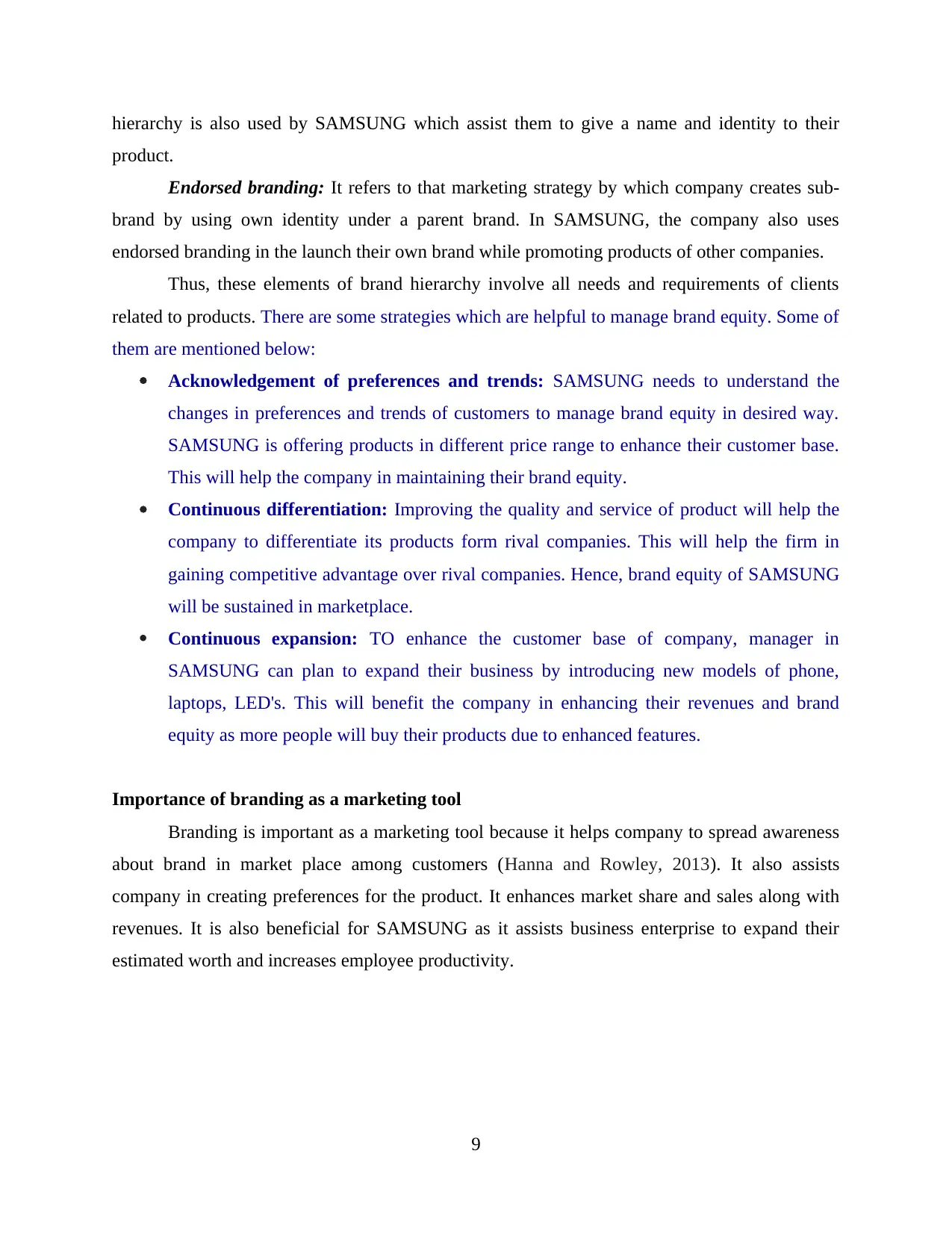
hierarchy is also used by SAMSUNG which assist them to give a name and identity to their
product.
Endorsed branding: It refers to that marketing strategy by which company creates sub-
brand by using own identity under a parent brand. In SAMSUNG, the company also uses
endorsed branding in the launch their own brand while promoting products of other companies.
Thus, these elements of brand hierarchy involve all needs and requirements of clients
related to products. There are some strategies which are helpful to manage brand equity. Some of
them are mentioned below:
Acknowledgement of preferences and trends: SAMSUNG needs to understand the
changes in preferences and trends of customers to manage brand equity in desired way.
SAMSUNG is offering products in different price range to enhance their customer base.
This will help the company in maintaining their brand equity.
Continuous differentiation: Improving the quality and service of product will help the
company to differentiate its products form rival companies. This will help the firm in
gaining competitive advantage over rival companies. Hence, brand equity of SAMSUNG
will be sustained in marketplace.
Continuous expansion: TO enhance the customer base of company, manager in
SAMSUNG can plan to expand their business by introducing new models of phone,
laptops, LED's. This will benefit the company in enhancing their revenues and brand
equity as more people will buy their products due to enhanced features.
Importance of branding as a marketing tool
Branding is important as a marketing tool because it helps company to spread awareness
about brand in market place among customers (Hanna and Rowley, 2013). It also assists
company in creating preferences for the product. It enhances market share and sales along with
revenues. It is also beneficial for SAMSUNG as it assists business enterprise to expand their
estimated worth and increases employee productivity.
9
product.
Endorsed branding: It refers to that marketing strategy by which company creates sub-
brand by using own identity under a parent brand. In SAMSUNG, the company also uses
endorsed branding in the launch their own brand while promoting products of other companies.
Thus, these elements of brand hierarchy involve all needs and requirements of clients
related to products. There are some strategies which are helpful to manage brand equity. Some of
them are mentioned below:
Acknowledgement of preferences and trends: SAMSUNG needs to understand the
changes in preferences and trends of customers to manage brand equity in desired way.
SAMSUNG is offering products in different price range to enhance their customer base.
This will help the company in maintaining their brand equity.
Continuous differentiation: Improving the quality and service of product will help the
company to differentiate its products form rival companies. This will help the firm in
gaining competitive advantage over rival companies. Hence, brand equity of SAMSUNG
will be sustained in marketplace.
Continuous expansion: TO enhance the customer base of company, manager in
SAMSUNG can plan to expand their business by introducing new models of phone,
laptops, LED's. This will benefit the company in enhancing their revenues and brand
equity as more people will buy their products due to enhanced features.
Importance of branding as a marketing tool
Branding is important as a marketing tool because it helps company to spread awareness
about brand in market place among customers (Hanna and Rowley, 2013). It also assists
company in creating preferences for the product. It enhances market share and sales along with
revenues. It is also beneficial for SAMSUNG as it assists business enterprise to expand their
estimated worth and increases employee productivity.
9
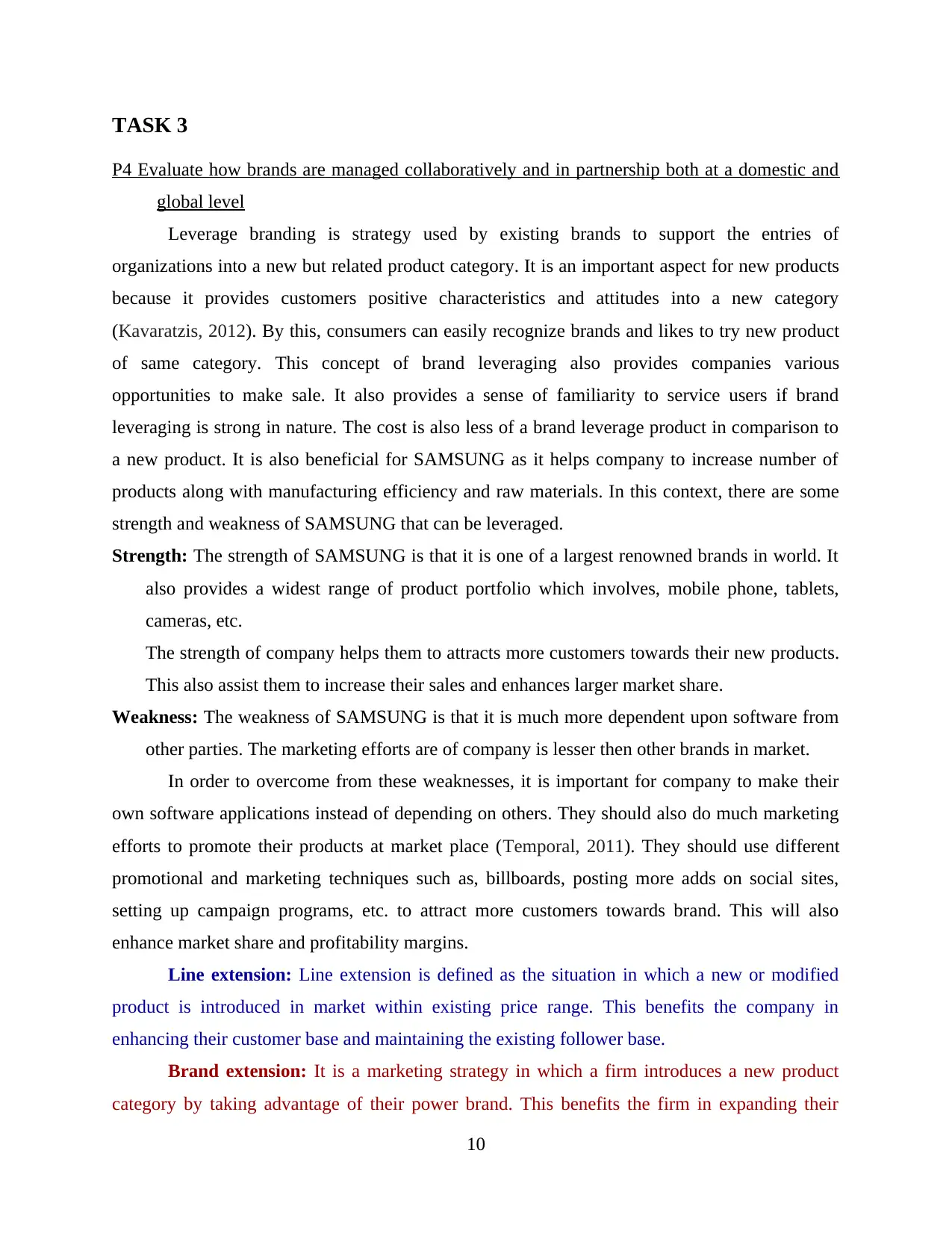
TASK 3
P4 Evaluate how brands are managed collaboratively and in partnership both at a domestic and
global level
Leverage branding is strategy used by existing brands to support the entries of
organizations into a new but related product category. It is an important aspect for new products
because it provides customers positive characteristics and attitudes into a new category
(Kavaratzis, 2012). By this, consumers can easily recognize brands and likes to try new product
of same category. This concept of brand leveraging also provides companies various
opportunities to make sale. It also provides a sense of familiarity to service users if brand
leveraging is strong in nature. The cost is also less of a brand leverage product in comparison to
a new product. It is also beneficial for SAMSUNG as it helps company to increase number of
products along with manufacturing efficiency and raw materials. In this context, there are some
strength and weakness of SAMSUNG that can be leveraged.
Strength: The strength of SAMSUNG is that it is one of a largest renowned brands in world. It
also provides a widest range of product portfolio which involves, mobile phone, tablets,
cameras, etc.
The strength of company helps them to attracts more customers towards their new products.
This also assist them to increase their sales and enhances larger market share.
Weakness: The weakness of SAMSUNG is that it is much more dependent upon software from
other parties. The marketing efforts are of company is lesser then other brands in market.
In order to overcome from these weaknesses, it is important for company to make their
own software applications instead of depending on others. They should also do much marketing
efforts to promote their products at market place (Temporal, 2011). They should use different
promotional and marketing techniques such as, billboards, posting more adds on social sites,
setting up campaign programs, etc. to attract more customers towards brand. This will also
enhance market share and profitability margins.
Line extension: Line extension is defined as the situation in which a new or modified
product is introduced in market within existing price range. This benefits the company in
enhancing their customer base and maintaining the existing follower base.
Brand extension: It is a marketing strategy in which a firm introduces a new product
category by taking advantage of their power brand. This benefits the firm in expanding their
10
P4 Evaluate how brands are managed collaboratively and in partnership both at a domestic and
global level
Leverage branding is strategy used by existing brands to support the entries of
organizations into a new but related product category. It is an important aspect for new products
because it provides customers positive characteristics and attitudes into a new category
(Kavaratzis, 2012). By this, consumers can easily recognize brands and likes to try new product
of same category. This concept of brand leveraging also provides companies various
opportunities to make sale. It also provides a sense of familiarity to service users if brand
leveraging is strong in nature. The cost is also less of a brand leverage product in comparison to
a new product. It is also beneficial for SAMSUNG as it helps company to increase number of
products along with manufacturing efficiency and raw materials. In this context, there are some
strength and weakness of SAMSUNG that can be leveraged.
Strength: The strength of SAMSUNG is that it is one of a largest renowned brands in world. It
also provides a widest range of product portfolio which involves, mobile phone, tablets,
cameras, etc.
The strength of company helps them to attracts more customers towards their new products.
This also assist them to increase their sales and enhances larger market share.
Weakness: The weakness of SAMSUNG is that it is much more dependent upon software from
other parties. The marketing efforts are of company is lesser then other brands in market.
In order to overcome from these weaknesses, it is important for company to make their
own software applications instead of depending on others. They should also do much marketing
efforts to promote their products at market place (Temporal, 2011). They should use different
promotional and marketing techniques such as, billboards, posting more adds on social sites,
setting up campaign programs, etc. to attract more customers towards brand. This will also
enhance market share and profitability margins.
Line extension: Line extension is defined as the situation in which a new or modified
product is introduced in market within existing price range. This benefits the company in
enhancing their customer base and maintaining the existing follower base.
Brand extension: It is a marketing strategy in which a firm introduces a new product
category by taking advantage of their power brand. This benefits the firm in expanding their
10
⊘ This is a preview!⊘
Do you want full access?
Subscribe today to unlock all pages.

Trusted by 1+ million students worldwide
1 out of 20
Related Documents
Your All-in-One AI-Powered Toolkit for Academic Success.
+13062052269
info@desklib.com
Available 24*7 on WhatsApp / Email
![[object Object]](/_next/static/media/star-bottom.7253800d.svg)
Unlock your academic potential
Copyright © 2020–2025 A2Z Services. All Rights Reserved. Developed and managed by ZUCOL.




